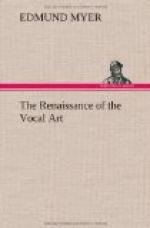An important point to consider in this connection is the fact that there is no strength properly applied without movement; but when right movements are not used, the voice is pushed and forced by local effort and by contraction of the lung cells and of the throat. This of course means physical restraint, and physical restraint prevents self-expression. Singing is more psychological than physiological; hence the importance of free self-expression. Direct physical effort produces physical effect; relaxation produces depression.
All artistic tone is reinforced sound. There are two ways of reinforcing tone. First, by direct muscular effort, the wrong way; second, by expansion and inflation, the added resonance of air in the cavities, the right way. This condition of expansion and inflation is the distinguishing feature of many great voices, and is possible only through right bodily position and action. These movements are used by many great artists, who develop them as they themselves develop, through giving expression to thought, feeling, and emotion, through using the impressive, persuasive tone, the fervent voice. This brings into action the entire vocal mechanism, in fact all the powers of the singer; hence these movements become a part of the great artist. He may not be able to give a reason for them, but he knows their value. The persuasive, fervent voice demands spontaneity and automatic form and adjustment; these conditions are impossible without flexible, vitalized movements. The great artist finds by experience that the throat was made to sing and not to sing with; that he must sing from the body through the throat. He finds that the tone must be allowed and not made to sing. Hence in the most natural way he develops vitalized bodily energy.
Next in importance to absolute freedom of voice, which these movements give, is the fact that through them absolute, automatic, perfect breath-control is developed and mastered. These movements give the breath without a thought of breathing, for they are all breathing movements. The singer cannot lift and expand without filling the lungs naturally and automatically, unless he purposely resists the breath. The conscious breath unseats the voice, that is, disturbs or prevents correct adjustment, and thus compels him to consciously hold it; but this very act makes it impossible to give the voice freedom. Through these movements, through correct position, we secure automatic adjustment, which means approximation of the breath bands, the principle of the double valve in the throat, which secures automatic breath-control. In other words, the singer whose position and action are correct need never give his breathing a thought. This is considered by many as the greatest problem—for the singer—solved in the nineteenth century.
To study and master these movements and apply them practically, the singer needs to know absolutely nothing of the mechanism of his vocal organs. He need not consider at all the physiological side of the question. Of course the study of these movements must at first be more or less mechanical, until they respond automatically to thought or will. Then they are controlled mentally, the thought before the action, as should be the case in all singing; and finally the whole mechanism, or all movements, respond naturally and freely to emotional or self-expression.




